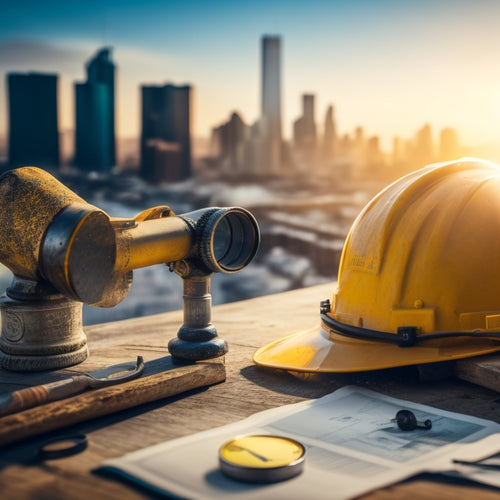
3 Steps to a Successful Commercial Solar Power Installation
Share
You'll need to assess your energy needs, designing a system that meets your unique requirements. This involves conducting energy audits, identifying areas for improvement, and accurately sizing your system to prevent wasted energy and increased costs. Next, you'll design and install the system, selecting high-efficiency components and ensuring compatibility and compliance with safety standards. Finally, you'll maximize energy savings through monitoring and maintenance, taking advantage of incentive programs, and staying informed on opportunities to enhance your return on investment. By following these three steps, you'll be well on your way to a successful commercial solar power installation, and a more in-depth exploration of each step will reveal even more opportunities for optimization.
Key Takeaways
- Assess energy needs through audits and usage data analysis to determine the ideal system size and identify energy-saving opportunities.
- Ensure proper system design and installation by selecting high-efficiency components, evaluating site potential, and integrating systems for optimal energy production.
- Maximize energy savings through regular monitoring and maintenance, taking advantage of incentive programs, and utilizing net metering agreements.
- Conduct thorough site evaluations to assess solar potential, considering factors like roof size, orientation, and shading.
- Prioritize compliance with safety and performance standards during installation to guarantee a successful and efficient commercial solar power installation.
Assessing Your Energy Needs
Several factors influence your energy needs, and understanding them is vital to a successful commercial solar power installation. You must consider your energy usage patterns, such as peak hours and seasonal variations, to determine the best system size.
Conducting energy audits is essential to assess your energy consumption and identify areas of improvement. These audits provide important information into your energy usage, helping you pinpoint opportunities to reduce energy waste and enhance your system's performance.
When it comes to system sizing, accuracy is key. Oversizing can lead to wasted energy and increased costs, while undersizing may not meet your energy demands.
By analyzing your energy usage data, you can determine the ideal system size that meets your energy needs. A thorough understanding of your energy requirements also enables you to identify potential energy-saving opportunities, such as energy-efficient lighting or HVAC upgrades.
Designing and Installing the System
Optimization is key when designing and installing a commercial solar power system, as a well-planned setup can maximize energy output and minimize costs.
You'll want to conduct a thorough site evaluation to assess your property's solar potential, considering factors like roof size, orientation, and shading. This will help you determine the ideal system size and configuration.
Next, you'll need to select the right equipment and materials for your system. This includes high-efficiency solar panels, inverters, and mounting hardware.
Be sure to choose components that are compatible and designed for commercial-scale installations.
During installation, system integration is essential. You'll need to guarantee that all components are properly connected and configured to optimize energy production.
This includes integrating your solar system with your existing electrical infrastructure and confirming that it meets all relevant safety and performance standards.
Maximizing Energy Savings
With a well-designed and installed commercial solar power system in place, you're now ready to reap the benefits of renewable energy and maximize your energy savings.
To get the most out of your investment, it's vital to monitor and maintain your system to guarantee peak performance. Regular system maintenance is important to identify and address any issues that could impact energy production. This includes inspecting panels for cleanliness, checking inverters for proper function, and verifying that all components are operating within specified parameters.
Additionally, take advantage of available incentive programs that can help offset the cost of your system. These programs may include tax credits, rebates, or net metering agreements that allow you to sell excess energy back to the grid.
By staying up-to-date on these opportunities, you can further maximize your energy savings and accelerate your return on investment.
Frequently Asked Questions
Can I Install Solar Panels on My Old or Damaged Roof?
You'll need a thorough roof assessment to determine if your old or damaged roof is suitable for solar panels; consider factors like structural integrity, leaks, and necessary repairs before installation considerations can even begin.
How Do I Ensure the System's Electrical Components Are Safe?
As you traverse the electrical labyrinth, think of your solar system as a harmonious orchestra, where each component plays an essential role; secure the maestro's safety by selecting durable parts, and conducting regular checks to prevent electrical discord, assuring a concert of efficiency and reliability.
Will Solar Panels Affect My Property's Resale Value?
You're wise to contemplate how your solar investment will impact your property's resale value; a property appraisal will likely increase your home's value, as solar panels are seen as a desirable, modern amenity that attracts eco-conscious buyers.
Can I Use Solar Power for Heating and Cooling Systems?
Think you're a solar superhero, utilizing the sun's power for everything? You're close! You can indeed use solar power for heating and cooling systems, enhancing cooling efficiency and providing solar heating through thermal collectors - it's a revolutionary development for your building's climate control.
Are There Any Local or State Incentives for Commercial Solar?
You'll be thrilled to find that, yes, there are local and state incentives for commercial solar, including federal tax credits and revenue-generating renewable energy certificates, which can considerably offset your system's cost and enhance your ROI.
Conclusion
As you near the finish line of your commercial solar power expedition, remember that capturing the sun's energy is like taming a wild horse - it requires patience, persistence, and precision. You've bridled your energy needs, saddled up with a well-designed system, and are now ready to gallop towards maximum energy savings. With these three steps, you'll be riding high, reaping the rewards of a successful commercial solar power installation that will leave your competition in the dust.
Related Posts
-

What You Need to Know About Permits and Inspections
You need to navigate the complex landscape of permits and inspections to guarantee your project complies with local z...
-

Planning for an Electric Vehicle-Friendly Urban Future
As you plan for an electric vehicle-friendly urban future, you'll need to integrate high-power charging stations, sma...
-

Safely Staying on Course: 5 Essential Lane Tips
You're about to take your driving skills to the next level by mastering the art of staying in your lane. First, inves...


